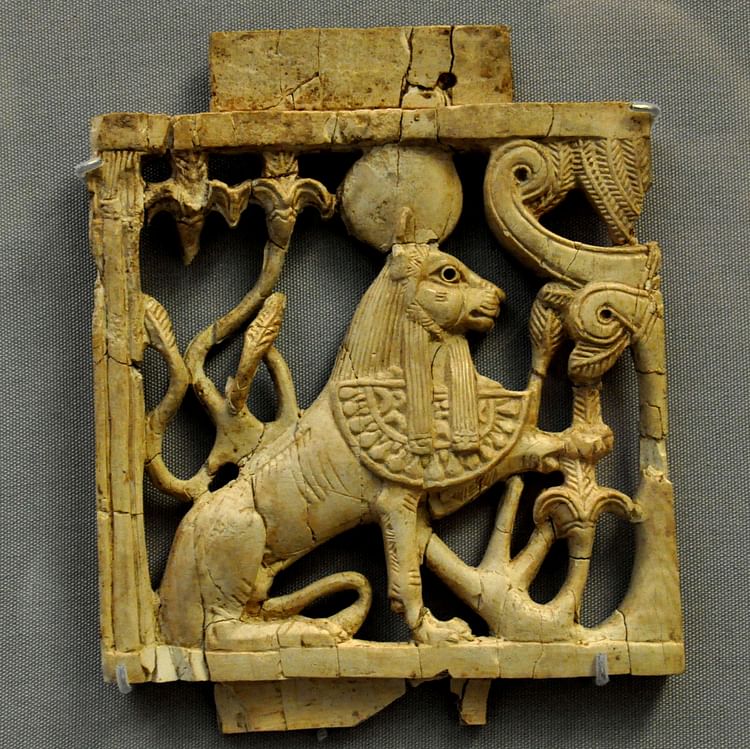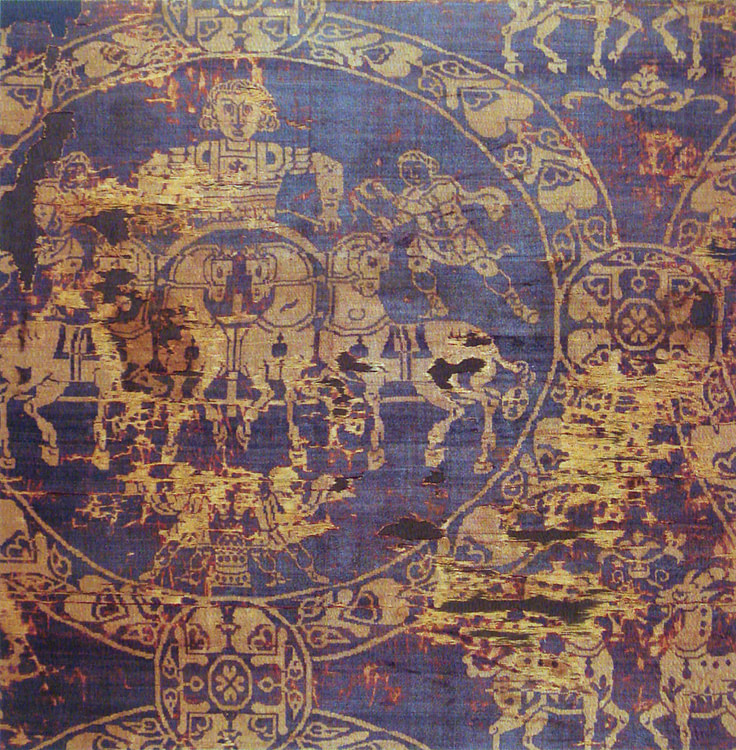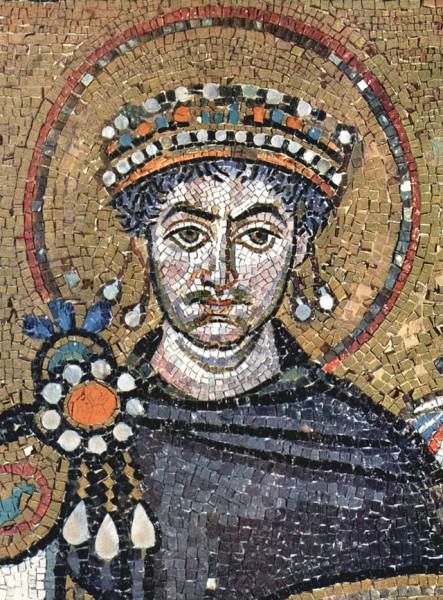Phoenician Art › Tyrian Purple » Ancient origins
Articles and Definitions › Contents
- Phoenician Art › Antique Origins
- Tyrian Purple › Who Was
Ancient civilizations › Historical and archaeological sites
Phoenician Art › Antique Origins
Definition and Origins

The art of the ancient Phoenicians, which flourished between the 19th and 4th centuries BCE, was exported throughout Mesopotamia and the ancient Mediterranean. Best known for their work on small decorative objects, Phoenician artists skillfully blended influences from neighbouring cultures to produce a unique artistic heritage that has only relatively recently been brought out of the shadow of a wider Syrian art history. Intricately carved ivory panels, exquisite metal bowls, and fine colourful glassware are just some of the surviving art pieces from one of history's most neglected and forgotten cultures.
ARTISTIC INFLUENCES
Phoenician art was influenced by that of its neighbours – Egypt, Mesopotamia, Anatolia, and the Aegean islands – with whom it had frequent contact through trade. The influence may be best seen in specific materials, for example, Aegean influence is most often seen in Phoenician pottery, Mesopotamian and Ugarit in metal work, and Egyptian in ivory work.Iconography, the clothing of figures, and the palm, lotus, and djed pillar motifs, for example, were borrowed from these contemporary cultures.
Another point of note is that Phoenician artists, unlike their contemporaries elsewhere, continued Bronze Age traditions long into the Iron Age; a fact which can make the accurate dating of certain works of art extremely difficult. Phoenician artists seem to have largely worked with ornamental objects, especially ivory plaques, seals, jewels, glassware, and metal bowls. These objects were exported or even made by Phoenician craftsman living in foreign cities and colonies; such was the appreciation of their skills and the finished product.
DECORATIVE PALMETTES, SPHINXES, LIONS, WINGED-SOLAR DISKS, & COLUMN MOTIFS ARE FREQUENTLY USED IN PHOENICIAN ART.
PHOENICIAN SCULPTURE
Surviving examples of large-scale Phoenician sculpture in stone are few and far between, probably because any stone worthy of sculpture had to be imported and so the artform was not as popular as in other cultures. One notable piece is the torso from Sarafand (Sarepta) which dates to the 6th century BCE and depicts a male in pleated skirt and belt, wearing a crescent moon pendant. Stone relief carvings include the important aedicule (small shrine) from Sidon which represents a monument-type much-copied by later Carthaginian sculptors. It has two columns creating a central space in which sat two sphinxes and is topped by a winged sun disk. This and other types of grave markers and stelae were a popular medium for Phoenician sculptors. Decorative palmettes, sphinxes, winged-solar disks, and column motifs are frequently used in such Phoenician relief sculpture. Stone sculptures were originally painted in bright colours but usually sparingly in order to pick out features and specific details.
The 9th-6th-century BCE stele from Amrit is an interesting example of the Phoenician artist mixing influences as the male figure wears an Egyptian skirt and headgear while the lion walks on stones representing a mountain, a common feature of Assyrian art. The man is typical of most Phoenician figures in all art forms – viewed from the side, both feet are flat on the ground, arms either hang at the sides or one arm is bent to hold an object, and the face stares impassively forward.

Sarcophagus of Ahiram
Finally, perhaps the most outstanding piece which survives from Phoenician sculpture is the 13th-12th-century BCE stone sarcophagus of King Ahiram of Byblos. The rectangular coffin is surrounded by a frieze of lotus buds and flowers, has crouching lions protruding from each base corner, and carries relief scenes of a procession and seated figure, perhaps Ahiram himself, and mourning women.
Bronze figurines up to 20 cm tall have been much better survivors than larger-scale works but these are often difficult to distinguish from those produced in other Syrian cultures. They are generally crude in execution but have individualistic features. Several are from Aleppo and date to the 9th and 8th century BCE. Female figures are more common and typically wear a long tunic. Male figurines often have one arm raised and wear a conical hat. Some statuettes, such as those found at the Temple of Obelisks at Byblos, were covered in gold leaf.

Reshef
PHOENICIAN IVORIES
Phoenician ivory plaques have been found in Mesopotamian cities (especially Nimrud ), the Greek islands, and central Italy.Only a very few have been discovered at Phoenician sites but those exported are identified by the incision of Phoenician letters and ended up where they did because the Phoenicians traded them, gave them as tribute (or were war booty in the case of Assyria ), or produced them on location in resident workshops. The plaques were used as decoration for walls, altars, incense burners, and items of furniture. The earliest date to the 9th century BCE and most are rectangular, carved in high relief, sometimes with gaps carved right through the piece. Lions, sphinxes, a winged-goddess, and a woman at a window are the most common subjects. As with relief sculpture in stone, they display influences from both Egypt and Assyria.

Lioness Devouring a Boy, Phoenician Ivory Panel
PRECIOUS METAL BOWLS
Phoenician artists were known in antiquity for their fine metalwork, famously, Achilles presents a beautiful silver crater from Phoenician Sidon as a prize for the funeral games of Patroclus in Homer ’s Iliad. Another case is Hiram of Tyre who was employed by Solomon to create two huge decorated bronze pillars and a 4.5-metre diameter bronze basin with groups of oxen as feet to adorn his temple at Jerusalem. On a more modest scale, Phoenician artists made highly crafted bowls made from bronze, silver, and gold. Produced during the 8th and 7th century BCE, surviving examples have been found as far afield as Nimrud, Delphi, and Salerno in Italy. Many examples carry Phoenician inscriptions, greatly helping to identify the origin of these highly transportable goods.
The subject matter of the embossed reliefs on these bowls is typical of the Phoenician tradition of mixing cultural influences from Mesopotamia, Greece, and Egypt into a single object. A central medallion is common on the interior, as are concentric bands of decoration. Geometrical and floral motifs prevail but, once again, sphinxes, animals, and human figures also appear.To describe but one example, a bronze bowl found at Olympia has an eight-pointed star and rosettes in the central medallion.Within two decorative bands runs a frieze of scenes where figures play music, perform religious ceremonies, and one figure kills a griffin. Each scene is divided by a nude standing female figure, probably a goddess. The bowl is typical of Phoenician art with a mix of influences but adapted and made highly decorative.

Phoenician Bronze Bowl From Nimrud
OTHER MINOR ARTS
Phoenician cities were great exporters of glassware, so much so that the ancients (incorrectly) attributed its invention to them.The Phoenicians actually learnt the techniques from the Egyptians but were able to improve them to produce fine transparent glass. Despite this, artists seem to have preferred working with opaque coloured glass (which has the appearance of ceramic) to produce bottles, jars and bowls. The most common shape was the alabastron and amphora form but in miniature and used for perfumes. The most common form of decoration is stripes of blues (from cobalt or copper ) and yellows (from iron oxide), punctuated by zig-zags.

Phoenician Glassware
Terracotta figurines (especially females) were produced, rather primitive in execution, often lavishly painted, and found mostly in grave contexts. Pottery, unfortunately, suffered from a lack of good clay. A common form was jugs, which usually have a lip, and the finest are made with a red-burnished finish. Few vessels carry any decoration, and if so, it is merely achieved via incised simple geometric shapes and lines.
Phoenician artists carved seals, especially scarab seals from semi-precious stones where the base is incised with names and decorative devices. Not only used as seals they were also carried as amulets and worn as rings and pendants. Once again sphinxes, winged deities, and solar disks are common. Finally, jewellery was also produced, often in gold or glass, and finds include necklaces, bracelets, pectorals, pins, earrings, and medallions. Some of the gold examples have repoussé decoration.Agate, onyx, and crystal were also used to produce beads for jewellery whilst small circular glass plaques were pierced with holes so that they might be sewn onto clothing.

Phoenician Scarab Seal
CONCLUSION
Phoenician art spread to its colonies throughout the Mediterranean from the 8th century BCE and none more so than at the most successful Phoenician off-shoot: Carthage. Artists there were strongly influenced by and perpetuated Phoenician styles and subject matter up to the 2nd century BCE. Meanwhile, with the rise of Greece from the 5th century BCE, Phoenician art in the homeland became increasingly Hellenized as it continued its eclectic path towards mixed forms, which led to such oddities as Egyptian anthropoid sarcophagi with very Greek-looking faces carved on their exteriors. Long famous as traders and sailors, the Phoenicians, then, are slowly, as more and more of their art is discovered and known pieces are correctly attributed, gaining wider recognition as having been capable of producing just as fine art pieces as their contemporaries in Egypt and Mesopotamia.
Tyrian Purple › Who Was
Definition and Origins

Tyrian purple (aka Royal purple or Imperial purple) is a dye extracted from the murex shellfish which was first produced by the Phoenician city of Tyre in the Bronze Age. Its difficulty of manufacture, striking purple to red colour range, and resistance to fading made clothing dyed using Tyrian purple highly desirable and expensive. The Phoenicians gained great fame as sellers of purple and exported its manufacture to its colonies, notably Carthage, from where it spread in popularity and was adopted by the Romans as a symbol of imperial authority and status.
MANUFACTURE
In Phoenician mythology, the discovery of purple was credited to the pet dog of Tyros, the mistress of Tyre's patron god Melqart. One day, while walking along the beach the couple noticed that after biting on a washed up mollusc the dog's mouth was stained purple. Tyros asked for a garment made of the same colour and so began the famous dyeing industry.
The first historical record of the dye is in texts from Ugarit and Hittite sources, which indicate that the manufacture of Tyrian purple began in the 14th century BCE in the eastern Mediterranean. Cloth dyed with Tyrian purple was a hugely successful export and brought the Phoenicians fame throughout the ancient world. Indeed, some historians (but certainly not all) claim that the very name Phoenicia derives from the Greek word phoinos meaning 'dark red' which refers to the dye and may itself be a translation of the Akkadian word for both Canaan and red, kinahhu. Despite their formidable reputation, the dyers of Tyre did not have a monopoly on the process even in the Late Bronze Age as four Linear B tablets from Knossos indicate that it was manufactured (albeit on a small scale) on Minoan Crete too, which also had a supply of the shellfish in its coastal waters.
TYRIAN PURPLE DYE WAS LITERALLY WORTH MORE THAN ITS WEIGHT IN GOLD.
The dye was extracted from the fluid of the Murex trunculus, Purpura lapillus, Helix ianthina, and especially the Murex brandaris shellfish. Living in relatively deep water, these shellfish were caught in baited traps suspended from floats. The dye was then extracted from the glands of thousands of putrefied crushed shellfish left to bake in the sun. The resulting liquid was used to dye cloth fibres in manipulated variations of colours ranging from pink to violet. One can imagine the smell from the process must have been overwhelming and perhaps explains why Sidon ’s workshop was 14 kilometres south of the city at Sarepta.
In his Natural History the Roman writer Pliny the Elder describes how the dye extraction process had by then developed.Taking three days, salt was added to the mash of shellfish glands which was then boiled down in tins. Finally, whole fleeces were dipped into the mixture when the correct hue had been reached. Fibres were dyed before weaving them into clothes and only very rarely would completed garments have been dyed; perhaps very valuable ones might have been redyed.

Murex Brandaris
According to the historian B. Caseau, "10,000 shellfish would produce 1 gram of dyestuff, and that would only dye the hem of a garment in a deep colour" (Bagnall, 5673). These numbers are supported by the quantity of discarded shells which, at Sidon for example, created a mountain 40 metres high. Such figures also explain why the dye was worth more than its weight in gold.In a 301 CE price edict from the reign of Roman emperor Diocletian, we learn that one pound of purple dye cost 150,000 denarii or around three pounds of gold (equal to around $19,000 at the time of writing ). A pound of pre-dyed wool would set you back one pound of gold.
Such was the demand for Tyrian purple that vast deposits of the shells have been excavated on the outskirts of Sidon and Tyre and the species was all but driven to extinction along the coasts of Phoenicia. The Phoenicians not only exported the dyed cloth but also the process of extracting the dye, as indicated by the shell deposits found at Phoenician colonies across the Mediterranean. Carthage was particularly involved in its manufacture and continued to spread its fame into Roman times and the Byzantine period. In antiquity, besides the Phoenician cities and Carthage, other known manufacturing centres included Rhodes, Lesbos, Motya ( Sicily ), Kerkouane (North Africa) and various other places in Asia Minor and southern Italy.
Tyrian purple was always the finest on the market as the Phoenicians (and through inheritance perhaps also the Carthaginians) not only had access to the raw material but years of experience. They were expert at blending different species of shellfish in certain sequences of the process and adding extra secret ingredients so that only they could produce the most prized colour of all, a rich deep purple which seemed crimson when held to the light. Tyrian purple was also noted for its great durability and lack of fading. As with any luxury product, there were cheaper, if less effective, alternatives to the real thing.Purple could be produced from certain lichens or first dyeing using red (madder) and then overdyeing using blue (woad). The Gauls used whortleberry to die textiles purple, which were, ironically, then made into clothes for slaves.
USES
The primary function of Tyrian purple was to dye textiles, especially clothing. The highest quality cloth was known as Dibapha, meaning 'twice dipped' in the purple dye. Because of the time-consuming production process, the huge number of shells required, and striking colour range of finished articles, such dyed textiles were, of course, a luxury item. As a consequence, Tyrian purple became a status symbol representing power, prestige and wealth. The high value of purple cloth is further indicated by its presence on tribute lists alongside other precious goods such as silver and gold which Tyre was obliged to pay to the Assyrian kings in the 9th and 8th centuries BCE. Alexander the Great, too, was said to have come across 5,000 talents in weight of purple cloth at Susa, likely acquired through tribute and kept as a permanent deposit of high value. The still bright colour 180 years after its manufacture did much to enhance the already formidable reputation for the durability of Tyrian purple cloth.

Justinian I
The status-conscious Romans were particularly fond of purple garments and reserved them for the elite only. The imperial family, magistrates and some elites were permitted to wear the toga praetexta which had a purple border, and generals who celebrated a Roman Triumph could wear on their big day the toga picta which was entirely purple with a gold border. In time, the colour purple came to represent the emperor, although it was Julius Caesar who first wore the all-purple toga purpurea.By the 5th century CE purple and silk formed a winning combination, and its production became a state monopoly from the reign of Alexander Severus (222 - 235 CE). Only the emperor could wear these silk garments ( kekolumena ) or those lucky enough to be given his favour, and no foreigner was permitted to purchase them. Emperors were even depicted wearing Tyrian purple, too, such as the celebrated mosaic portrait of Justinian I in the Basilica of San Vitale, Ravenna. Purple was long associated with the priesthood from Roman times onwards, and it was not until 1464 CE that Pope Paul II ordered the replacement of purple robes with scarlet ones for Church vestments.
It is thought that such was the symbolism of purple in ancient Rome that even imperial monuments and sarcophagi came to include it in the form of porphyry marble which has a deep and uniform purple colour. Besides textiles, Tyrian purple was sometimes used to dye parchment and several examples of Late Antiquity texts dyed purple survive, such as the Codex Rossano.
LICENSE:
Article based on information obtained from these sources:with permission from the Website Ancient History Encyclopedia
Content is available under License Creative Commons: Attribution-NonCommercial-ShareAlike 3.0 Unported. CC-BY-NC-SA License